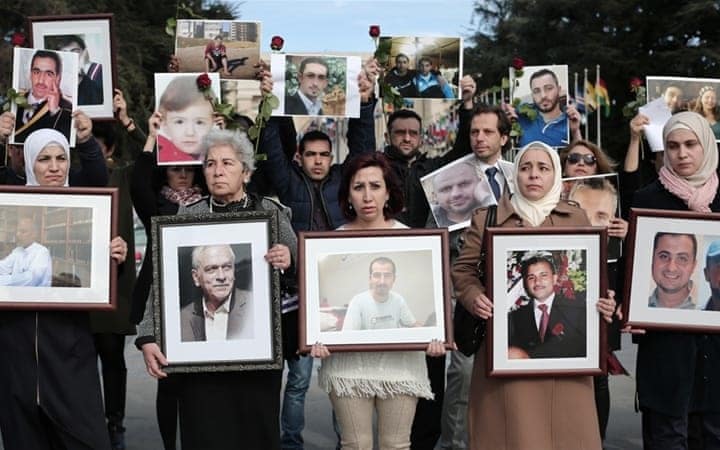Relatives with photographs of detainees who disappeared in Assad regime prisons, Geneva, February 2017 (Dylan Collins/Al Jazeera)
Trying to cover up its mass killings, Syria’s Assad regime carried out a secret two-year operation to rebury bodies in a mass grave in the remote desert.
The regime killed tens of thousands of civilians during Syria’s uprising from March 2011 through ground assaults, executions, and torture and poor conditions in detention. It was finally toppled in December 2024, with Bashar al-Assad and members of his inner ciricle fleeing to Russia.
The Assad military excavated thousands of bodies from a mass grave in Qutayfah, east of Damascus, and transported them to the desert outside the town of Dumayr.
Reuters spoke to 13 people with direct knowledge of “Operation Move Earth” from 2019 to 2021. The outlet reviewed documents and analyzed hundreds of satellite images of both grave sites taken over the course of several years.
The witnesses explained that the operation sought to cover up the Assad regime’s crimes and restore its image as, enabled by Russia and Iran, it pushed back the Syrian opposition.
The Dumayr site has at least 34 trenches measuring 2 km (1.2 miles) long. Tens of thousands of people could be buried there.
For four nights almost every week from February 2019 to April 2021, six to eight trucks filled with dirt and human remains arrived from Qutayfah. Among those testifying to the operation, including the system, were two truckers, three mechanics, a bulldozer operator and a former officer from Assad’s Republican Guard.
The regime buried the dead at Qutayfah from 2012. They included soldiers and detainees who died in prisons and military hospitals.
A Syrian human rights activist revealed the mass graves at Qutayfah in 2014, releasing photos to local media. Its precise location was established a few years later in court testimony and media reports.
The Republican Guard officer said the idea for the transport to Dumayr arose in late 2018, as Asaad hoped to regain international recognition.
More than 160,000 people disappeared and are believed to be buried in dozens of mass graves, says Syrian rights groups.
Syria’s new National Commission for Missing People has announced plans to create a DNA bank and a centralized digital platform for families of the missing. It cited and an urgent need to train specialists in forensic medicine and DNA testing.
“There is a bleeding wound as long as there are mothers waiting to find the graves of their sons, wives waiting to find the graves of their husbands, and children waiting to find the graves of their fathers,” said Emergency and Disaster Management Minister Raed al-Saleh al-Saleh in late August.

